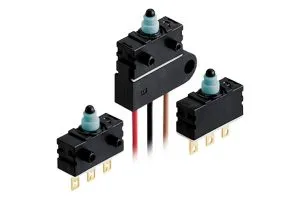As they are for detecting the position of objects rather than finger operation, they have a long action with ~8mm of travel – despite the body measuring ~6 x 9 x 16mm.
Each has three terminals, with the two contacts sharing one of them.
‘Two steps detect’
ASQD1xxCO types, are normally open and have one contact that closes early in the button’s travel, followed by the second closing 1.7mm further into the travel.
Use is expected in open-ajar-closed detection for doors that are manually pushed nearly closed, after which they are fully closed with power assistance. The aim is “to prevent pinching before door closing assist starts”, said the company.
ASQD1xxBO is the same as …CO, except the contacts are both closed at rest, and then open one after the other during pushing.
‘Redundency’
ASQD1xxEO types are normally-open and have two contacts that close at the same time, giving a high probability that at least one will close when the button is pushed – with warning of the potential of total failure if both contacts are fed into separate reading circuits. Door-open detection is application that Panasonic sees for this type, saying: “It is the first time that such a concept has been realised with a three-terminal switch.”
ASQD1xxDO is the same as …EO, but normally-closed.
‘Failure detection’
ASQD1xxAO is essentially a change-over switch, with one contact opening as the other closes. All single faults are detectable, said the company: breaks or shorts in the three wires leading to the switch, either contact jammed open, or either contact jammed closed. They are for “devices that must not fail. Functional safety will be the main reason to use this solution”.
Beyond their different actions, all five kinds of switch have common features:
They all have pre-travel and post-travel, and none of them have mechanical hysteresis – there is no ‘snap’ action. Instead any particular contact opens and closes at the same displacement, and silently.
Four kinds of terminations are available: solder tags, flying leads and two types use-once force-fit terminations – the latter intended to be pushed over conductive spikes of 0.8mm across or 0.64mm across.
They are sealed to IP67, and operation is over -40 to +85°C, 5 to 16V and 1 to 50mA for an electrical life of 3 x 105 operations.
The switches can be operated at up to 200 times per minute, but “when switching at low and high speeds or under vibration, or in high-temperature, high-humidity environments, life and performance may be reduced significantly, depending on the load capacity”, said Panasonic.

